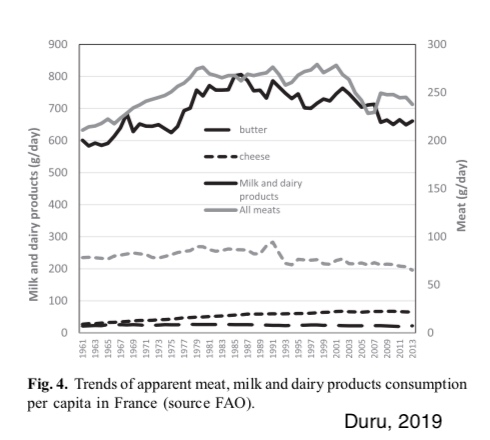ATA-RI
|
Article scientifique M. Duru Trends in agri-food choices for health since the 1960s: the case of fatty acids OCL, 2019, 26, 44 The FA composition of our diet affects human health: SFAs and n-6 PUFAs in excess are a risk factor for a number of chronic diseases, while n-3 PUFAs have a protective role. These FAs should be considered together, since an excessively high n-6:n-3 ratio is linked to a strong pro-inflammatory effect. We reconstructed the FA composition of the French diet from the 1960s to the present to identify the main reasons for decreases or increases due to agriculture, food processing or food choices. From the 1960s to the late 1990s, the diet increased in SFA and n-6 PUFA levels and likely decreased in n-3 PUFA level. Consequently, food behaviors did not follow dietary recommendations. For SFAs, this was due to the sharp increase in cheese and, to a smaller extent, palm oil consumption. For n-6 PUFAs, it was due to the sharp increase in oil consumption, especially linoleic sunflower oil. For n-3 PUFAs, this was due mainly to replacement of grass by maize and soybean meal to feed ruminants. This trend has reversed since the 2000s: the SFA level decreased due to decreased consumption of palm oil and genetic improvements in pigs and poultry, n-6 PUFA level decreased due to increased consumption of oleic instead of linoleic sunflower oil, and n-3 PUFA level increased due to increased consumption of rapeseed oil. These changes are consistent with the FA composition observed in breast milk. Despite these improvements, however, the average dietary composition remains far from the recommendations, especially for n-3 PUFAs. We show the potential for improvement by supplementing animal feed with flaxseed and increasing consumption of oleic sunflower and rapeseed oils, at the expense of that of other oils.Keywords: dairy products, diet, feed, meat, oil, polyunsaturated fatty acids, saturated fatty acids A consulter ici : https://www.ocl-journal.org/articles/ocl/abs/2019/01/ocl190027/ocl190027.html  |